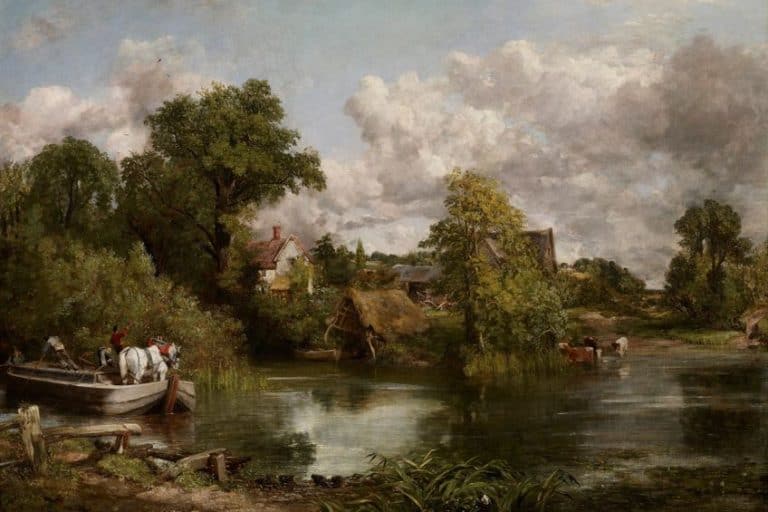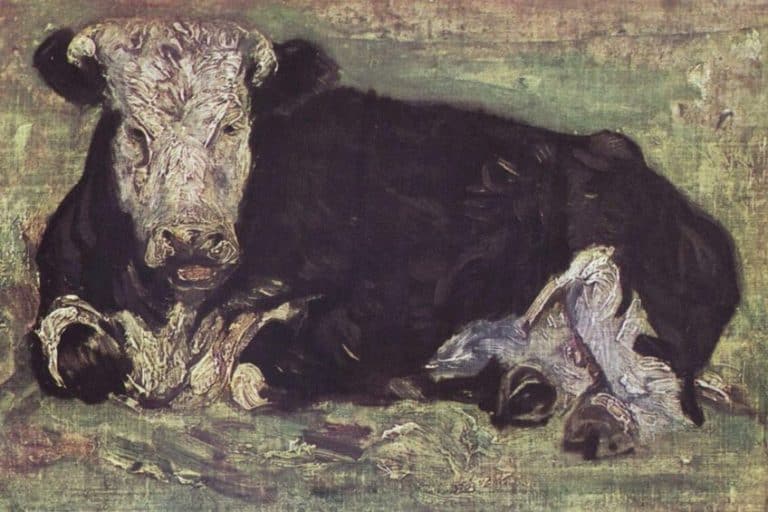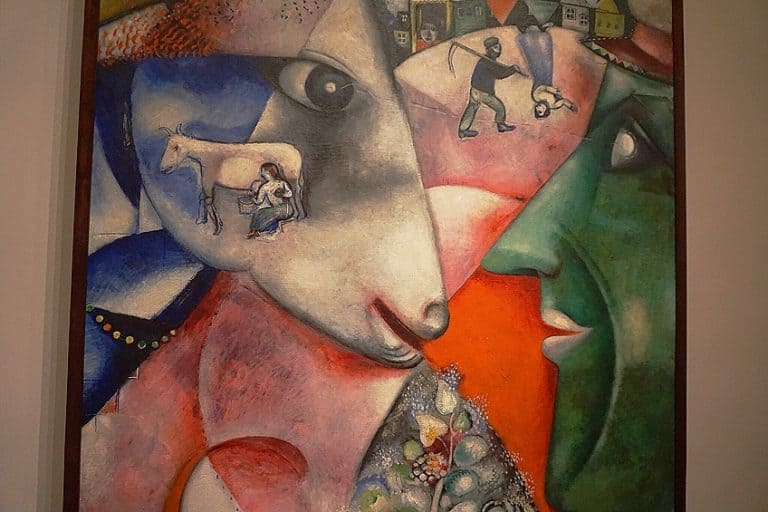“Let My People Go” by Aaron Douglas – The Art of Freedom
Let My People Go, created by Aaron Douglas between 1935 and 1939, stands as a powerful testament to the Harlem Renaissance’s vibrant artistic and cultural movement. As a leading figure in this era, Douglas combined modernist techniques with African motifs to craft a unique visual language that resonated deeply with the African American experience. This artwork, with its striking use of silhouette and light, portrays the biblical story of Moses demanding the Pharaoh to release the Israelites from bondage, symbolizing the broader struggle for freedom and civil rights. Douglas’s evocative style and profound themes make Let My People Go an enduring piece that continues to inspire and provoke thought on issues of liberation and justice.
Key Takeaways
- Aaron Douglas was a key figure in the Harlem Renaissance.
- Let My People Go depicts the biblical plea for freedom, symbolizing the fight against oppression.
- The painting remains relevant today, showcased at the Metropolitan Museum of Art.
Artist Background and Significance
| Artist | Aaron Douglas (1899 – 1979) |
| Date Created | 1935 – 1939 |
| Medium | Oil on masonite |
| Genre | Figurative Art |
| Period/Movement | Harlem Renaissance |
| Dimensions (cm) | 121.9 x 91.4 |
| Series/Versions | None |
| Where Is It Housed? | The Metropolitan Museum of Art, New York City, United States |
| What It Is Worth | Estimated at $500,000 – $1 million (value based on recent market trends and historical significance) |
Aaron Douglas’s Let My People Go stands as a powerful testament to his artistic prowess and the strength of the Harlem Renaissance. Painted between 1935 and 1939, this striking piece uses bold hues of lavender and yellow-gold to draw you into its captivating narrative. The artwork revisits designs Douglas created in 1926 to illustrate James Weldon Johnson’s God’s Trombones: Seven Negro Sermons in Verse, enriching its biblical themes with a unique visual style. Douglas, an African American painter and graphic artist, played a crucial role in the Harlem Renaissance, a cultural movement that celebrated Black artistic expression in the 1920s and 1930s. His work not only defined an era but also provided a profound commentary on the social and political struggles faced by African Americans at the time.

Let My People Go is particularly notable for its symbolic portrayal of Moses’s plea to the Pharaoh, serving as a metaphor for the fight against oppression. Displayed at the Metropolitan Museum of Art, this oil on masonite painting is recognized for its Art Deco and Cubism influences, making it a significant piece in American art history. It remains a pertinent reminder of the ongoing struggle for freedom and equality, resonating with contemporary audiences just as it did when it was first created. Douglas’s legacy endures, inspiring new generations of artists and activists committed to social justice.
Harlem Renaissance Influence
Aaron Douglas emerged as a prominent artist during the Harlem Renaissance, a cultural movement centered in New York during the 1920s and 1930s. This period saw a flourishing of African American art, literature, and music. Douglas’s works were part of this vibrant cultural landscape. His style combined modernism with traditional African themes, creating visually striking images that spoke to the African American experience.
By incorporating African motifs and bold geometric shapes, Douglas helped to create a unique visual language that captured the essence of the Harlem Renaissance.
Contribution to African American Art
Douglas significantly impacted African American art by addressing social and political themes in his work. His painting, Let My People Go, is a powerful depiction of the Biblical story of Moses, also reflecting the struggles of African Americans during his time.

Through his art, Douglas provided a voice for African American struggles and aspirations. He was not only an artist but also an educator and activist, advocating for greater representation and opportunities for African American artists. His work at institutions like Fisk University helped to nurture the next generation of African American artists.
Cultural and Historical Context
Aaron Douglas’s Let My People Go draws on both biblical stories and the ongoing struggles for civil rights and social justice during the Harlem Renaissance. These elements are pivotal for understanding the depth and significance of the painting.
Biblical and Social Narratives
The title, Let My People Go, refers to Moses demanding freedom for the Israelites from Egyptian slavery. Aaron Douglas uses this powerful imagery to highlight parallels with African American experiences. During the early 20th century, African Americans faced systemic racism and inequality. These biblical references lent spiritual weight and historical context to the fight for civil rights. The painting emerged from the Harlem Renaissance, a cultural movement that celebrated African American art, literature, and music. Influenced by Cubism and Art Deco, Douglas employed modern art techniques to depict social courage and hope.
Figures in his work are often shown in a symbolic manner, emphasizing collective action and resilience. Key figures such as W.E.B. Du Bois and Alain Locke were instrumental in advocating for African American self-expression and cultural validation, significantly influencing Aaron Douglas’s artistic vision. Their ideas helped shape the themes of freedom and equality that permeate his work. Additionally, organizations like the NAACP played a crucial role in reinforcing these themes, providing a supportive backdrop for Douglas’s powerful depictions of the African American experience.
Let My People Go stands as a testament to the ongoing struggle against oppression, merging artistic brilliance with social activism.
Analysis of Let My People Go
Let My People Go by Aaron Douglas is a significant work that combines historical themes with striking artistic techniques. The painting uses color, line, and symbolism to tell a powerful story.
Subject Matter
Let My People Go is part of a series revisiting Aaron Douglas’s designs for James Weldon Johnson’s God’s Trombones: Seven Negro Sermons in Verse. The painting depicts a scene from the Old Testament where Moses leads the Israelites out of Egypt. Douglas focuses on the theme of freedom, drawing parallels between the biblical story and the struggles of African Americans.
Moses stands as a symbol of hope and leadership, guiding his people towards liberation.
Use of Color and Line
Douglas employs lavender and yellow-gold hues in Let My People Goo. These colors create a radiant effect, emphasizing the divine and hopeful aspects of the narrative. The use of bold lines and geometric shapes is notable. These elements reflect the influence of the Art Deco and Cubism movements. Lines direct the viewer’s gaze, enhancing the sense of movement and guiding attention to key figures.

Symbolism and Themes
Symbolism is rich throughout Let My People Go. Moses is a central figure symbolizing deliverance. The painting draws a connection between the biblical exodus and the African American fight for freedom. African American history is subtly referenced through imagery, linking past struggles to contemporary movements.
The use of spiritual and biblical motifs serves to reinforce the theme of liberation and divine justice.
Artistic Techniques
Douglas used oil on masonite, a material that allows for vibrant, durable colors. His technique demonstrates precision and control. Combining Art Deco and Cubist styles, Douglas uses overlapping shapes and dynamic compositions to create depth. These techniques build a sense of narrative progression and highlight crucial aspects of the story. His disciplined brushwork results in a polished, cohesive piece that communicates both visually and thematically.

Legacy and Present-Day Impact
Aaron Douglas’s work Let My People Go has left a lasting mark on art and culture. His unique style and themes continue to inspire and influence modern artists and cultural institutions.
Collections and Exhibitions
Let My People Go is an important piece in the collection of the Metropolitan Museum of Art in New York. The painting is part of Gallery 999 and regularly attracts visitors with its vibrant colors and historical significance. Additionally, Fisk University also holds notable works by Douglas, highlighting his role in shaping African American art. Special exhibitions on the Harlem Renaissance often feature Douglas’s work. These exhibits showcase his influence on Art Deco and Cubism.
His art not only symbolizes a key period in history but also helps educate new generations about the cultural and social issues of his time.
Continued Relevance and Interpretation
Douglas’s Let My People Go remains relevant today, reflecting the struggles and triumphs of African Americans. Modern artists often reference his work, emphasizing themes of freedom and equality. Educational programs frequently discuss his contributions to modernism and African American art.

Art institutions like the National Gallery of Art use his pieces to explore the intersections of art, history, and social justice. Curators and historians continue to find new layers of meaning in Douglas’s work, ensuring that his legacy endures. Through continued exhibitions and scholarly research, Douglas’s influence on both culture and art remains profound.
Let My People Go encapsulates the spirit of resilience and the enduring quest for freedom that marked the Harlem Renaissance. Through his innovative use of silhouettes and layered imagery, Douglas not only tells a biblical tale but also reflects the contemporary struggles of African Americans in the 1930s. The artwork serves as a poignant reminder of the past while continuing to inspire future generations to strive for equality and justice. Its lasting impact lies in its ability to transcend time, speaking to universal themes of liberation and human dignity, ensuring that Douglas’s vision remains relevant and powerful in the present day.
Frequently Asked Questions
What Is the Significance of Let My People Go in Illustrating the Experiences of African Americans?
Aaron Douglas’s painting Let My People Go is inspired by the biblical story of Moses and the Exodus. It creates a parallel to the African American fight for freedom and equality. Through its depiction, the painting highlights the ongoing social and racial challenges faced by African Americans during the early 20th century.
How Has Aaron Douglas’s Work, Including Let My People Go, Influenced Modern Art?
Aaron Douglas is known for integrating elements of Art Deco and Cubism into his paintings. Let My People Go demonstrates his unique style, combining modernism with African themes. His work has inspired many artists by merging abstract forms with a strong narrative on African American heritage and identity.
What Connections Can Be Found Between Let My People Go and Other Works Within the Series Aspects of Negro Life?
Let My People Go is part of a larger series called Aspects of Negro Life, which includes eight panels. Each piece in the series addresses different facets of African American life and history. The paintings collectively portray the journey from slavery to freedom, emphasizing the resilience and contributions of African Americans to society.
Isabella studied at the University of Cape Town in South Africa and graduated with a Bachelor of Arts majoring in English Literature & Language and Psychology. Throughout her undergraduate years, she took Art History as an additional subject and absolutely loved it. Building on from her art history knowledge that began in high school, art has always been a particular area of fascination for her. From learning about artworks previously unknown to her, or sharpening her existing understanding of specific works, the ability to continue learning within this interesting sphere excites her greatly.
Her focal points of interest in art history encompass profiling specific artists and art movements, as it is these areas where she is able to really dig deep into the rich narrative of the art world. Additionally, she particularly enjoys exploring the different artistic styles of the 20th century, as well as the important impact that female artists have had on the development of art history.
Learn more about Isabella Meyer and the Art in Context Team.
Cite this Article
Isabella, Meyer, ““Let My People Go” by Aaron Douglas – The Art of Freedom.” Art in Context. July 9, 2024. URL: https://artincontext.org/let-my-people-go-by-aaron-douglas/
Meyer, I. (2024, 9 July). “Let My People Go” by Aaron Douglas – The Art of Freedom. Art in Context. https://artincontext.org/let-my-people-go-by-aaron-douglas/
Meyer, Isabella. ““Let My People Go” by Aaron Douglas – The Art of Freedom.” Art in Context, July 9, 2024. https://artincontext.org/let-my-people-go-by-aaron-douglas/.











